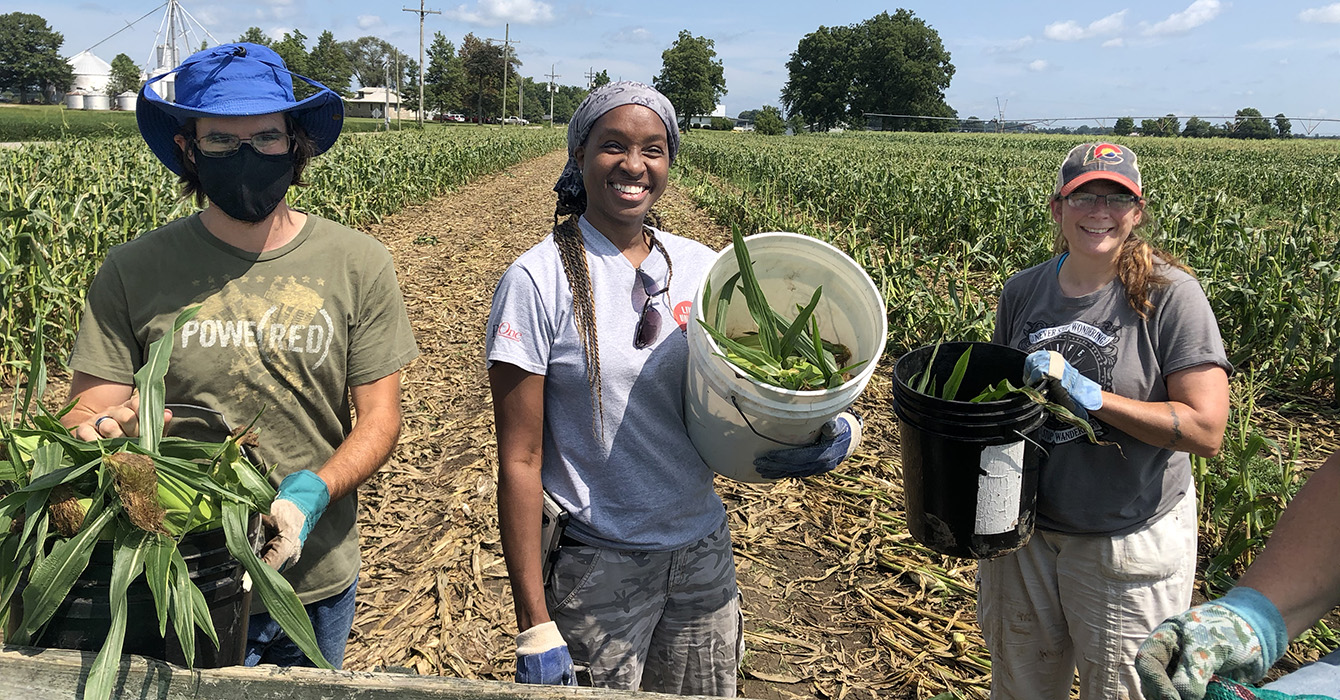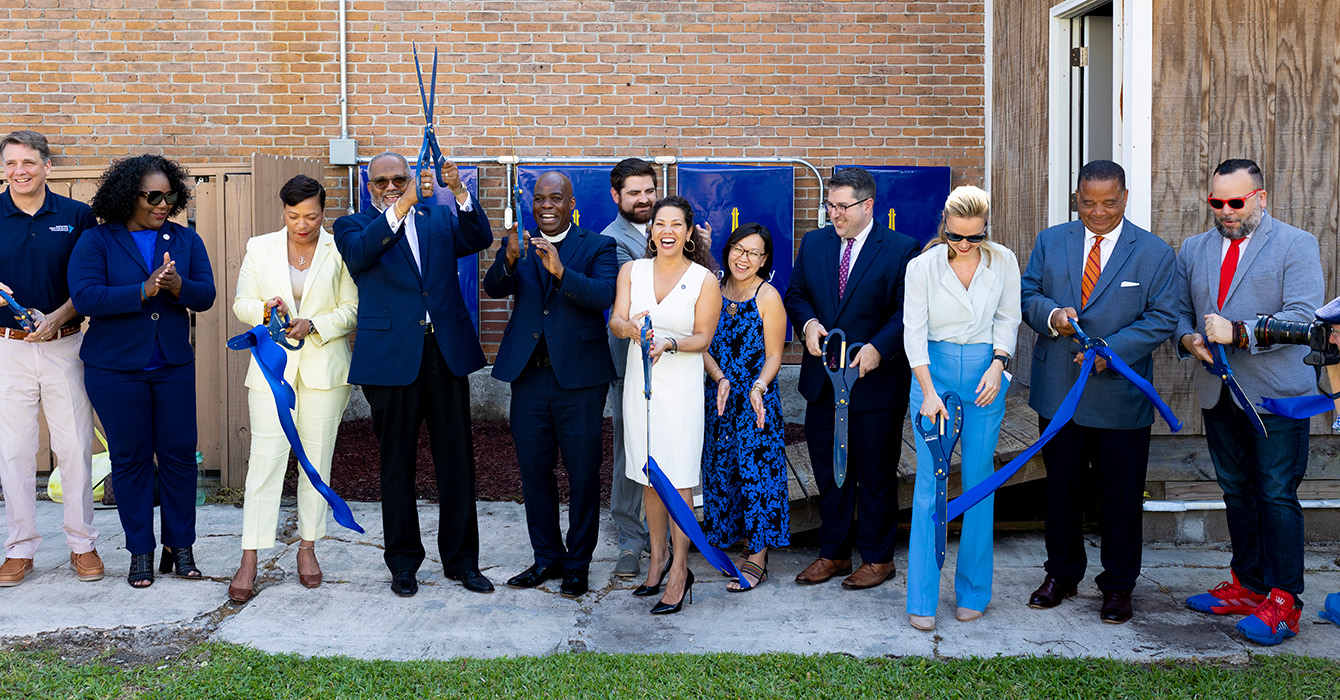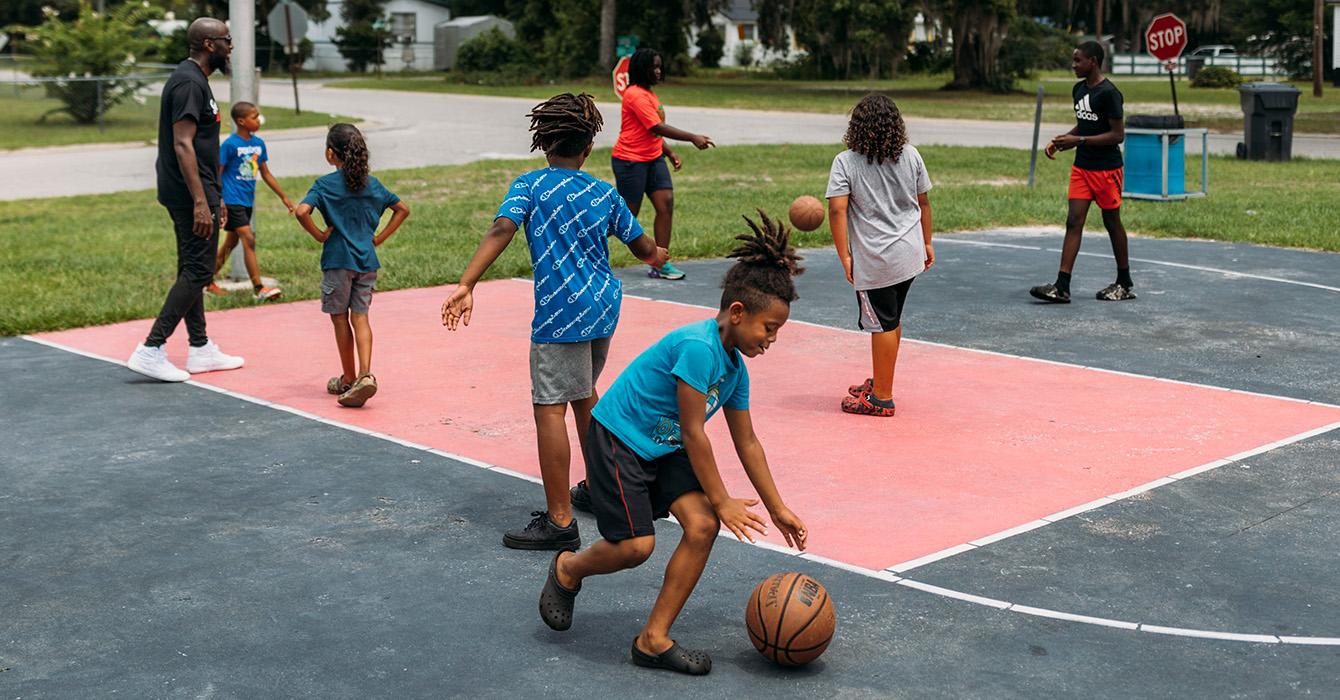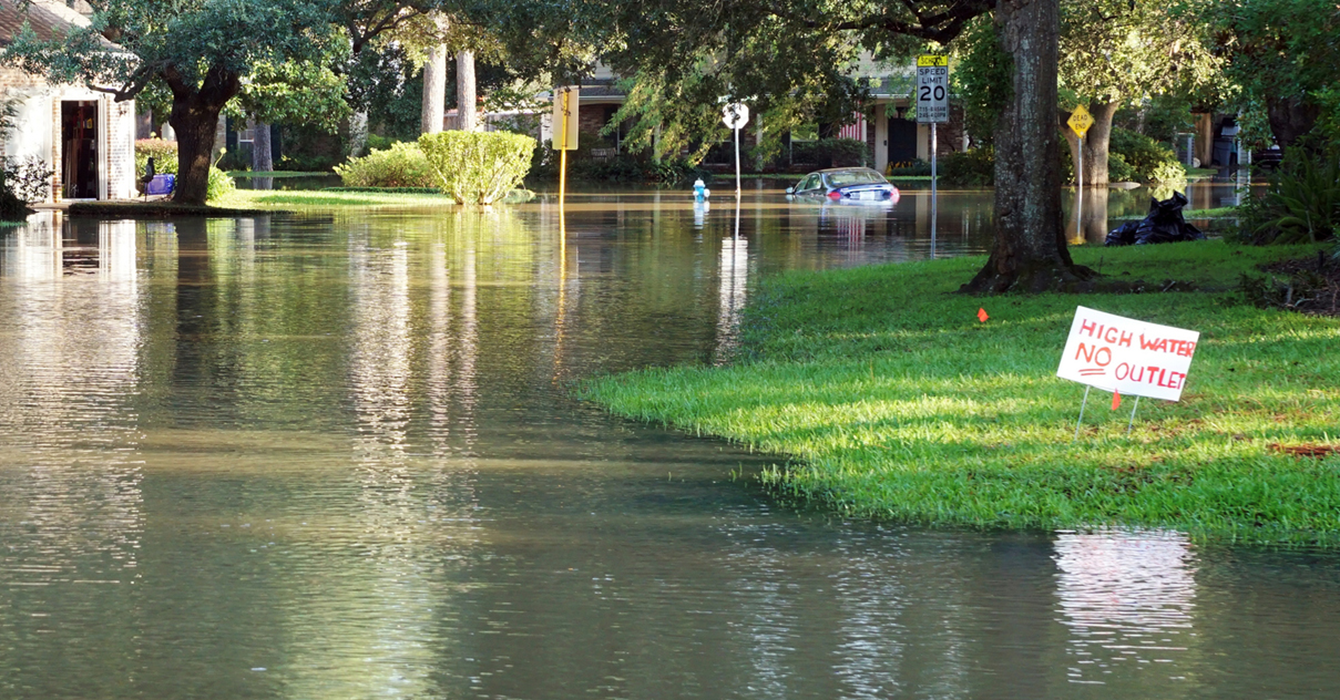One bright October afternoon, Jacqueline Jones stood in her church’s pollinator garden, sporting a floral-patterned cap while caring for the purple coneflowers blooming at her feet. The church community had planted the vegetation steps away from a nearby traffic light, and the garden was capturing drivers’ attention.

“It’s amazing how many people have taken the time while they’re sitting there to ask about it,” said Jones, co-chair for outreach at St. Mark’s United Methodist Church located in Laurel, Maryland. “And some of them have even said, ‘Well, I’m going to come by for church Sunday.’
“You know, we do a lot of things to grow the church community and get people to come to the church. But that garden, in its own little way, has done a lot to inform the community about the purpose of a pollinator garden — and even interest them in the church.”
That’s just one example of the connection between native plants and faith communities that has bloomed from the National Wildlife Federation’s Sacred Grounds program, which seeks to help houses of worship like churches, mosques and synagogues with activities such as project planning and technical expertise to increase native plant gardens.
Houses of worship in three regions have taken part in this program, either through educational programs or by receiving official designation as Sacred Grounds sites.

“All the faiths have a connection with some version of stewarding the land, some version of caring for creation,” said Naomi Edelson, the senior director for wildlife partnerships at the National Wildlife Federation and founder of Sacred Grounds.
“Our theology is that God is creator of all. And so everything begins with God as creator. And God has called us to be stewards,” said the Rev. Cary James Jr., the senior pastor of Jones Memorial United Methodist Church in Washington, D.C., which also participates in the program.
“What it means to be a steward is to be a caretaker of God’s creation in all forms, I tell people — the air, the land and the sea.”
The program offers houses of worship a practical way to invest in creation care. And, as Jones of St. Mark’s UMC discovered, it can have benefits for the congregation as well.
The importance of native plants
When you think of beautiful grounds, you may think of well-manicured lawns featuring Bermuda grass or Kentucky bluegrass. Or you may think of luxurious gardens featuring tropical plants like palms and plumeria.
But if these grasses and other plants are not native to your environment, what looks beautiful could actually cause harm.
“Native plants have evolved with the native wildlife,” Edelson said. Plants that occur naturally in a region — and were not introduced there by humans — typically thrive in the soils, moisture and weather of that region.

This ability to thrive means that native plants need less (potentially wasteful) watering than nonnative plants, and they’ll have fewer pest problems that could require toxic chemicals. And because many have deep root systems, native plants also help manage rainwater runoff and maintain healthy soil.
One of the most important attributes of native plants is to provide food for wildlife that so-called exotics typically don’t, Edelson said.
The National Wildlife Federation effort is based in part on the research of Douglas Tallamy, who is a professor of agriculture and natural resources at the University of Delaware. Tallamy, the author of “Nature’s Best Hope: A New Approach to Conservation That Starts in Your Yard,” promotes the idea of transforming American lawns into ecologically rich spaces that can help combat lost habitat.
“What Doug Tallamy’s research demonstrates scientifically is how planting native plants supports this whole web of creatures and this whole ecosystem of things that rely on the plants,” said Joelle Novey, who has worked with Sacred Grounds as the director of Interfaith Power and Light (DC.MD.NoVA), a group that mobilizes people of faith on climate change. “It’s profound.”
For example, Edelson points to Tallamy’s research on caterpillars, an important protein source for many species. But caterpillars can eat only plants they evolved with, and while an oak tree can support 500 kinds of caterpillars, a ginkgo or a Bradford pear will have only one or two, Edelson said.
So if a property has trees that don’t support its local caterpillars, the local insect-eating birds, which may eat thousands of caterpillars, won’t have a reliable food source.
Plus, when pollinators — which include bees, butterflies, bats, birds and even moths — don’t have the food sources they need, human food sources suffer. That’s because three-fourths of the world’s flowering plants and about 35% of the world’s food crops depend on animal pollinators to reproduce, according to the U.S. Department of Agriculture (USDA).
The emerald expanses of grass that some property owners cherish can also pose environmental problems. Turf grass has shallow roots which means it cannot filter or absorb much water, Edelson said. And if the lawns are watered and fertilized, that runoff can be detrimental.
And some nonnative plants are invasive and can grow so rapidly that they crowd out native plants.
Sacred Grounds suggests replacing a portion of lawn with native plants, which can then help bring back hummingbirds and butterflies and more. Jones of St. Mark’s UMC can attest to this — she said she’s seen bees and butterflies as she has maintained her church’s garden.
“The pollinators, they really took to it. There were several bees out there, buzzing around. And the butterflies,” Jones said. “It may be because the library across the street has pollinators and they found a new territory.”
How can a vibrant native plant garden serve as a witness of hope to a community?

Sacred Grounds
The National Wildlife Federation, a nonprofit conservation organization known to many by its mascot, Ranger Rick, has had a program for more than 50 years to encourage and help people create wildlife habitats in schools and homes and businesses, Edelson said.
One day in 2012, she was having lunch with her rabbi to talk about how the federation could engage the faith community. He suggested expanding the existing program to congregations, she said, and the idea became a hit.
“It was such a natural fit,” said Edelson. “We found that once we started reaching out to congregations, … they were very interested.” She noted that while there has been a movement to “green” the inside of buildings, there hadn’t been as much attention to greening them outside.
Sacred Grounds started in 2012 with three congregations in the Washington, D.C., metro area and got a small grant, Edelson said. As time went on, Sacred Grounds reached more congregations by hosting larger workshops on gardening with organizations like Interfaith Power and Light (DC.MD.NoVA).
Over the years, the program has also worked with municipalities and received additional grants ranging from $50,000 to several hundred thousand dollars, allowing the federation to expand on-the-ground operations in the Washington, D.C., metro area as well as the mid-Atlantic region and the Great Lakes region, including Toledo and Detroit. Grants have come from benefactors such as the Chesapeake Bay Trust, the Wildlife Conservation Society, and the National Fish and Wildlife Foundation, Edelson said.
The program has also reached hundreds of congregations nationwide via educational webinars and individual workshops that can range from one to three hours in length, Edelson said.
In addition to education, Sacred Grounds often has provided funding for the gardens, native plant starter kits and honoraria for some programs, according to Edelson. Costs to create a garden can start at about $1,000, and a faith community that receives an honorarium can use it for needs such as garden care or even stipends for volunteers, she said.
Participating congregations also receive a toolkit so they can fulfill the program’s elements of creating a native garden on their grounds, connecting their faith to environmental stewardship, engaging their congregations, and reaching out to the larger community, Edelson said.
What theological frame for planting native gardens speaks to your faith community?

A blossoming connection
Like many congregations, Christ Congregational Church in Silver Spring, Maryland, had been limited to virtual services in 2020 because of COVID-19.
Edelson approached the church to suggest that they join Sacred Grounds. Alison Petersen, co-chair of the church’s Stewards of the Earth team, said she was happy to promote it to her congregation — and it provided an opportunity for church members to see each other in person again.
“In ’21, my church really got into it. I learned that we had some master naturalists and master gardeners in the congregation, and they were already well aware of native plants,” Petersen said.
And since her church already had a tradition of giving away plants on Mother’s Day, she thought they could “build upon it” by giving away native plants, she said.
Their first plant giveaway was outside on Mother’s Day 2021, offering members an occasion to see each other in person for one of the first times since COVID hit. This idea of a native plant giveaway for Mother’s Day eventually spread to other Sacred Grounds congregations.
In addition, the church added landscaping with native plants to combat a water runoff problem with the help of Sacred Grounds funding, Petersen said. During the planting in 2021, squads of Boy Scouts completed tasks like shoveling mulch and placing small flags on a tilled plot of land to mark where plants should go. And two parents labeled signs for the plants featuring their common names, Latin names and sketches.
Volunteers planted tall and clump-forming switchgrass and Pennsylvania sedge closest to the flow of water, with other plants like bluestar flowers and New England asters (found throughout Maryland) farther down the hill.
“Churches, one, are part of the community. I think it’s important for them to be beacons of hope, beacons of education, beacons of change in a community, that they can model the work that needs to be done by everyone,” Petersen said.
“This is a community engagement project,” Edelson said, noting that the congregations help support each other as sources of inspiration and healing.
And communities have responded. Participating congregations have introduced themselves to neighbors by offering native plants, and plant pickup days tend to attract people from surrounding communities, Novey of Interfaith Power and Light said.
For example, Jones said that St. Mark’s UMC connects with its community — beyond the idling drivers who admire the church’s pollinator garden — by giving away native plants such as blackeyed Susans for Mother’s Day and its annual 5K walk/run that benefits patients with diabetes.
Any person can receive the plants — with plugs packaged in biodegradable bags — and Jones estimated that the church has given away about 200 just for Mother’s Day in the past two years.
Church members and neighbors came together to plant the original garden and later relocate plants that grew taller than expected, with the community engagement team from the local police station even joining early planting efforts, Jones said.
“It’s really pulled the community together,” she said. “Ministry comes in many forms.”
At Jones Memorial UMC in Washington, D.C., James, the senior pastor, has seen community members respond to his church’s efforts as they’ve worked with Sacred Grounds over three years.
James, who has a background in environmental engineering, grew up on a 30-acre farm in Alabama, and when he met Edelson, he felt an instant bond between her work and his love for nature and nature education.
His church has also given away native plants for Mother’s Day, helped people learn about wildlife habitats and native plants, and educated the community about topics such as pollinators and runoff water through activities like webinars.
Jones Memorial UMC has also offered hands-on teaching such as showing the community how to plant seedlings in a garden or pot and how to sheet mulch to organically remove grass, he said.
Sacred Grounds participants share traditions, such as the Mother’s Day plant giveaway. Are there congregations you could partner with in shared activities or interests?

The church developed a pollinator garden featuring more than 900 native plants, with volunteers from students to older community members planting blackeyed Susans, sweet goldenrods and more in a 900-square-foot circular space that had previously held grass. James said the pollinator garden; the community outreach, focus groups and webinars; and the native plants for the giveaway were completely funded by Sacred Grounds.
“I can’t wait until it blooms this year,” James said. “We are so grateful for the funding; we’re so grateful for the relationships that we have built because of them.
“It’s been a great way for us to build relationships with the community, because sometimes they’re a little reluctant or hesitant to talk to the church,” James said. “So this is a way that it’s kind of a neutral territory that impacts all of us — creation — where we can have some conversation, education, and get people more excited about God’s creation.”
How might your congregation find spiritual motivation to plant a native garden?

Why churches? The theology of caring for nature
There are practical reasons why churches might plant native gardens: to beautify their property, to provide a natural oasis within a city or even to solve landscaping problems.
Faith communities include local leaders, and houses of worship often have lawns and big parking lots that can have an impact on stormwater runoff, Edelson said.
But for Christians, there are also theological reasons.
“The story of faith is never simply a story about people,” said Norman Wirzba, the Gilbert T. Rowe Distinguished Professor of Theology and director of research for the Office of Climate and Sustainability at Duke University.
“We certainly need to talk about people, but we also need to expand it to include the whole human world, because our human life depends on all of these other creatures. And if they’re not healthy, we’re not going to be healthy either,” he said.
In addition, issues related to climate change (such as sea level rise and extreme heat) have gained attention from people in a variety of industries, from health care to engineering, Wirzba explained, noting that faith communities also should play a role in these efforts and have a moral and spiritual reason to do so.
“One of the things that I’m especially interested in doing is help people remember that the world that we live in is important to think about seriously. That the land matters. Water matters. Plants, animals, creatures — they all matter,” he said.
As many churches are seeing their membership decline, Wirzba said, caring for the Earth can be seen as a side issue.
“Many Christians see that the things that matter are maybe the salvation of souls or growing church attendance,” he said, noting that those things do matter. But if Christians think the care of the Earth doesn’t matter, they can lose a generation of young people who are convinced that it does, he said.
Another thing to remember? “Jesus was constantly feeding people,” Wirzba said. “Food is not simply about counting calories but ultimately about fellowship,” he said, pointing to the Eucharist, a meal “at the heart of Christian liturgy.”
But if there are no crops, there is no bread.
Stewardship is an additional way to understand the work, said James of Jones Memorial UMC. As caretakers of God’s creation, we shouldn’t destroy it out of convenience or to make money, he said.
“Just from that theological framework, we help people to understand that this land really doesn’t belong to us,” he said. “Let’s make sure that we’re good stewards so we can leave it for future generations.”
What resources does your faith community already have that could support a native plant garden?
Interested in learning more about Sacred Grounds?
The National Wildlife Federation’s Sacred Grounds program works with faith communities to promote wildlife habitats and to engage the broader community in the process. More information about Sacred Grounds:
- Getting started with Sacred Grounds
- Community engagement ideas
- Native plant resources
- A native gardening toolkit, to be released this summer; find out more by emailing sacredgrounds@nwf.org
Other sources of information about native plants:
- U.S. Forest Service
- USDA plants database
- Audubon native plants database
- Cooperative Extension Services in each state
- Native Plant Finder based on Douglas Tallamy's research
Questions to consider
- How can a vibrant native plant garden serve as a witness of hope to a community?
- What theological frame for planting native gardens (creation care, feeding neighbors, offering witness, etc.) speaks to your faith community?
- Sacred Grounds participants share traditions, such as the Mother’s Day plant giveaway, as well as ideas and information. Are there congregations you could partner with in shared activities or interests?
- How might your congregation find spiritual motivation to plant a native garden?
- What resources does your faith community already have (people, space, partnerships) that could support a native plant garden?


















